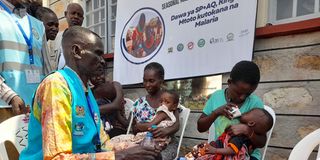Turkana bets on new malaria prevention campaign after being declared high-burden county

Mr Joshua Ebei, a Community Health Promoter, administerers sulfadoxine-pyrimethamine + amodiaquine doses to children in Kanam Kemer, Turkana Central Sub-county on June 18, 2024.
What you need to know:
- The county has a high malaria prevalence of 39 per cent compared to the national average of six per cent.
Turkana, which has been classified as a high malaria burden county, is betting on an expanded new prevention campaign to curb malaria cases.
This is after health officials cited the Kenyan border with Uganda, Ethiopia and South Sudan as high-mobility zones, and major towns and refugee camps as the most hit.
The county has been officially categorised as a high malaria burden county in the 2023-2027 Kenya Malaria Strategy.
Records from Kenya Health Information System indicate that the county has a high malaria prevalence of 39 per cent compared to the national average of six per cent.
The first-ever malaria prevention campaign - Seasonal Malaria Chemoprevention (SMC) - that was conducted last year in Turkana Central Sub-county demonstrated that it can prevent malaria infection rate in children by up to 70 per cent, county health officials said.
The World Health Organization (WHO) defines SMC as the intermittent administration of a curative dose of antimalarial medicine to children, regardless of whether they are infected with malaria.
A total of 40,123 children aged between three to 59 months were reached out in cycles during the campaign between May and October when malaria was at its peak.
In each of the five cycles, coming up after 28 days, a child was being given dispersible sulfadoxine-pyrimethamine (SP) together with amodiaquine (AQ), a combination chosen due to its ability to provide relatively long-lasting protection to children because of their low immunity and their being prone to severe malaria.
Turkana Health Executive Joseph Epem said that with the county recording a high malaria prevalence, reliable prevention strategies are critical before cases surge during the rainy seasons.
“We require increased support through initiatives such as Seasonal Malaria Chemoprevention that should now be scaled across the county, including Kakuma Refugee Camp," Dr Epem said.
Last month, Public Health PS Mary Muthoni assured that Kenya is set to expand its malaria prevention efforts in Turkana with a second round of SMC from June to October this year.
"This will incorporate digital monitoring through the electronic Community Health Information System platform to improve tracking and data-driven decision-making. This is after the National Malaria Control Programme, the county government of Turkana, Moi University and Duke University conducted assessments that revealed a sharp increase in malaria infections during wet months," Ms Muthoni stated.
Health officials in the county noted that there was an increase in malaria cases since November 2023 when the Centres for Disease Control and Prevention warned that one of the deadliest mosquito species, which can transmit two parasites at once, had travelled by road in containers from Ethiopia to Kenya and would cause malaria infections in the country to surge.
The Anopheles stephensi mosquito, which can transmit both the plasmodium falciparum and plasmodium vivax malaria parasites, was found in Lodwar and Turkana, in addition to reports of being found in Marsabit.
County Preventive and Promotive Chief Officer Janerose Tioko said Anopheles stephensi is an invasive mosquito species thriving in urban areas. "It is resistant to current insecticides, resulting in more malaria cases," Ms Tioko said.
She, however, observed that the county has been a priority of national malaria prevention campaigns that included the September 2024 Long-Lasting Insecticidal Nets (LLINs) distribution campaign. More than 160,000 households benefited int eh campaign that targeted 22 high-burden counties.
Additionally, Turkana is collaborating with the International Centre of Insect Physiology and Ecology on a two-year research project, "Symbio Vector – Controlling Malaria from Within," in Katilu Ward. The study explores the use of inherited microbes to block malaria transmission by female mosquitoes.
Ms Tioko said the devolved unit is committed to accurate data collection, evidence-based resource allocation, community engagement, and integrated health services to achieve sustainable malaria control.
County Malaria Coordinator David Ekai said common malaria interventions in the past have primarily focused on case management, such as treatment and mass distribution of insecticide-treated nets.
“Studies have shown that mosquito behaviour has changed. They now bite outdoors, which means people are at risk of infection even before going to sleep under their nets. We are banking on new strategies like SMC and research to curb malaria,” he said.
Director of Medical Services, Dr Ekiru Kidalio, said Turkana is both a malaria-endemic region as it is reported all year round and a seasonal transmission zone due to the upsurges that occur during the rainy seasons.


